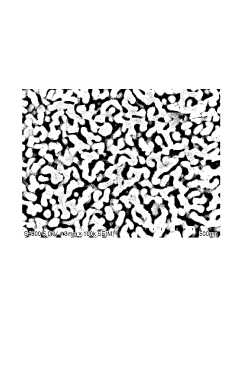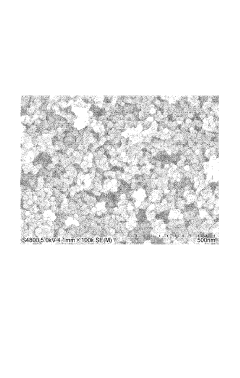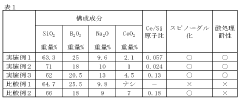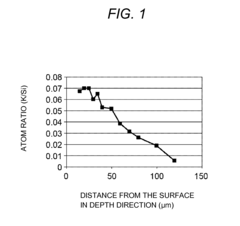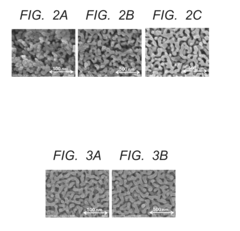Exploring Surface Porosity in Borosilicate Glass
JUL 3, 20259 MIN READ
Generate Your Research Report Instantly with AI Agent
Patsnap Eureka helps you evaluate technical feasibility & market potential.
Borosilicate Glass Porosity Background and Objectives
Borosilicate glass has been a cornerstone material in various industries for over a century, prized for its exceptional thermal and chemical resistance. The exploration of surface porosity in this versatile material represents a significant advancement in materials science and engineering. This investigation aims to uncover the intricate relationship between the glass composition, manufacturing processes, and the resulting surface characteristics.
The study of surface porosity in borosilicate glass has gained momentum in recent years due to its potential to enhance the material's properties and expand its applications. Historically, borosilicate glass has been valued for its low thermal expansion coefficient and high durability. However, the deliberate introduction of controlled surface porosity opens up new possibilities for tailoring its properties to meet specific industrial and scientific needs.
The evolution of borosilicate glass technology has seen a shift from focusing solely on bulk properties to a more nuanced understanding of surface characteristics. This transition has been driven by advancements in analytical techniques and a growing demand for materials with precisely engineered surfaces. The ability to manipulate surface porosity at the micro and nanoscale levels presents opportunities for innovations in fields such as catalysis, filtration, and biomedical applications.
Current technological trends in this area include the development of novel manufacturing processes that can create controlled porous structures on borosilicate glass surfaces. These methods range from chemical etching and thermal treatments to advanced techniques like laser ablation and sol-gel processes. Each approach offers unique advantages and challenges in achieving desired porosity profiles and surface properties.
The primary objectives of exploring surface porosity in borosilicate glass are multifaceted. Firstly, there is a need to establish a comprehensive understanding of the mechanisms governing pore formation and growth on glass surfaces. This knowledge is crucial for developing predictive models and optimizing manufacturing processes. Secondly, researchers aim to correlate surface porosity with specific material properties, such as increased surface area, enhanced reactivity, and modified optical characteristics.
Another key goal is to investigate the potential of porous borosilicate glass surfaces for novel applications. This includes exploring its use in advanced filtration systems, as a substrate for catalytic reactions, and in the development of controlled drug delivery systems. Additionally, there is significant interest in understanding how surface porosity affects the glass's mechanical properties, particularly its strength and fracture behavior.
The exploration of surface porosity in borosilicate glass also aligns with broader trends in materials science, such as the push towards more sustainable and multifunctional materials. By enhancing the surface properties of borosilicate glass, researchers hope to extend its lifespan, improve its recyclability, and potentially reduce the need for more resource-intensive materials in certain applications.
The study of surface porosity in borosilicate glass has gained momentum in recent years due to its potential to enhance the material's properties and expand its applications. Historically, borosilicate glass has been valued for its low thermal expansion coefficient and high durability. However, the deliberate introduction of controlled surface porosity opens up new possibilities for tailoring its properties to meet specific industrial and scientific needs.
The evolution of borosilicate glass technology has seen a shift from focusing solely on bulk properties to a more nuanced understanding of surface characteristics. This transition has been driven by advancements in analytical techniques and a growing demand for materials with precisely engineered surfaces. The ability to manipulate surface porosity at the micro and nanoscale levels presents opportunities for innovations in fields such as catalysis, filtration, and biomedical applications.
Current technological trends in this area include the development of novel manufacturing processes that can create controlled porous structures on borosilicate glass surfaces. These methods range from chemical etching and thermal treatments to advanced techniques like laser ablation and sol-gel processes. Each approach offers unique advantages and challenges in achieving desired porosity profiles and surface properties.
The primary objectives of exploring surface porosity in borosilicate glass are multifaceted. Firstly, there is a need to establish a comprehensive understanding of the mechanisms governing pore formation and growth on glass surfaces. This knowledge is crucial for developing predictive models and optimizing manufacturing processes. Secondly, researchers aim to correlate surface porosity with specific material properties, such as increased surface area, enhanced reactivity, and modified optical characteristics.
Another key goal is to investigate the potential of porous borosilicate glass surfaces for novel applications. This includes exploring its use in advanced filtration systems, as a substrate for catalytic reactions, and in the development of controlled drug delivery systems. Additionally, there is significant interest in understanding how surface porosity affects the glass's mechanical properties, particularly its strength and fracture behavior.
The exploration of surface porosity in borosilicate glass also aligns with broader trends in materials science, such as the push towards more sustainable and multifunctional materials. By enhancing the surface properties of borosilicate glass, researchers hope to extend its lifespan, improve its recyclability, and potentially reduce the need for more resource-intensive materials in certain applications.
Market Analysis for Porous Borosilicate Glass Applications
The market for porous borosilicate glass applications is experiencing significant growth, driven by increasing demand across various industries. Borosilicate glass, known for its excellent thermal and chemical resistance, has found new applications through the development of surface porosity techniques. This innovation has opened up opportunities in sectors such as filtration, catalysis, biomedical engineering, and energy storage.
In the filtration industry, porous borosilicate glass membranes are gaining traction due to their superior performance in separating particles and molecules at the micro and nanoscale. The market for these advanced filtration systems is expanding, particularly in water treatment, pharmaceutical manufacturing, and food processing industries. The ability to create controlled pore sizes and distributions in borosilicate glass has made it an attractive alternative to traditional polymer-based membranes.
The catalysis sector is another area where porous borosilicate glass is making significant inroads. Its high surface area and thermal stability make it an ideal support material for catalysts in chemical and petrochemical processes. The market for catalyst supports is growing steadily, driven by the need for more efficient and environmentally friendly production methods in these industries.
In biomedical engineering, porous borosilicate glass is finding applications in drug delivery systems and tissue engineering scaffolds. The biocompatibility of borosilicate glass, combined with its controllable porosity, allows for the development of advanced medical devices and implants. This segment of the market is expected to see rapid growth as healthcare technologies continue to advance.
The energy storage sector is also showing interest in porous borosilicate glass applications. Research is ongoing into using these materials in next-generation batteries and supercapacitors. The potential for improved energy density and cycle life is driving investment in this area, although commercial applications are still in the early stages of development.
Market analysis indicates that the global demand for porous borosilicate glass products is on an upward trajectory. While specific market size figures are not readily available due to the emerging nature of this technology, industry reports suggest a compound annual growth rate in the high single digits for specialized glass products, including porous borosilicate applications.
Geographically, North America and Europe are currently the leading markets for porous borosilicate glass applications, primarily due to their advanced research facilities and established industrial bases. However, Asia-Pacific is expected to be the fastest-growing market in the coming years, driven by rapid industrialization and increasing investment in advanced materials research in countries like China, Japan, and South Korea.
In the filtration industry, porous borosilicate glass membranes are gaining traction due to their superior performance in separating particles and molecules at the micro and nanoscale. The market for these advanced filtration systems is expanding, particularly in water treatment, pharmaceutical manufacturing, and food processing industries. The ability to create controlled pore sizes and distributions in borosilicate glass has made it an attractive alternative to traditional polymer-based membranes.
The catalysis sector is another area where porous borosilicate glass is making significant inroads. Its high surface area and thermal stability make it an ideal support material for catalysts in chemical and petrochemical processes. The market for catalyst supports is growing steadily, driven by the need for more efficient and environmentally friendly production methods in these industries.
In biomedical engineering, porous borosilicate glass is finding applications in drug delivery systems and tissue engineering scaffolds. The biocompatibility of borosilicate glass, combined with its controllable porosity, allows for the development of advanced medical devices and implants. This segment of the market is expected to see rapid growth as healthcare technologies continue to advance.
The energy storage sector is also showing interest in porous borosilicate glass applications. Research is ongoing into using these materials in next-generation batteries and supercapacitors. The potential for improved energy density and cycle life is driving investment in this area, although commercial applications are still in the early stages of development.
Market analysis indicates that the global demand for porous borosilicate glass products is on an upward trajectory. While specific market size figures are not readily available due to the emerging nature of this technology, industry reports suggest a compound annual growth rate in the high single digits for specialized glass products, including porous borosilicate applications.
Geographically, North America and Europe are currently the leading markets for porous borosilicate glass applications, primarily due to their advanced research facilities and established industrial bases. However, Asia-Pacific is expected to be the fastest-growing market in the coming years, driven by rapid industrialization and increasing investment in advanced materials research in countries like China, Japan, and South Korea.
Current Challenges in Surface Porosity Control
Controlling surface porosity in borosilicate glass remains a significant challenge in materials science and manufacturing. The primary difficulty lies in achieving precise and consistent pore sizes and distributions across the glass surface. This is crucial for applications requiring specific surface properties, such as filtration, catalysis, and biomedical implants.
One of the main challenges is the inherent variability in the glass composition and manufacturing processes. Borosilicate glass, while known for its thermal and chemical resistance, can exhibit inconsistencies in its microstructure due to slight variations in raw materials or processing conditions. These variations can lead to unpredictable pore formation during surface treatment processes.
The development of reliable and reproducible methods for creating controlled surface porosity is another significant hurdle. Current techniques, such as chemical etching, thermal treatment, and phase separation, often struggle to produce uniform pore sizes and distributions across large surface areas. This lack of uniformity can compromise the performance and reliability of the final product.
Furthermore, the interaction between the glass surface and the pore-forming agents or processes is not fully understood. This knowledge gap hinders the ability to fine-tune pore characteristics and predict the outcome of surface treatments accurately. Researchers are still working to elucidate the complex mechanisms involved in pore formation and growth on borosilicate glass surfaces.
Another challenge is the trade-off between surface porosity and mechanical strength. Increasing surface porosity often comes at the cost of reduced structural integrity, which can limit the practical applications of the material. Balancing these competing properties requires careful optimization of the pore-forming process and potentially the development of new glass compositions or surface treatment techniques.
The characterization and measurement of surface porosity also present technical difficulties. Current analytical methods may not provide sufficient resolution or accuracy to fully capture the nuances of pore size, shape, and distribution. This limitation hampers efforts to develop and validate improved porosity control techniques.
Lastly, scaling up laboratory-developed methods for industrial production poses significant challenges. Processes that work well on small samples may not translate effectively to large-scale manufacturing, necessitating further research and development to bridge this gap. The cost-effectiveness and environmental impact of these processes also need to be considered for commercial viability.
One of the main challenges is the inherent variability in the glass composition and manufacturing processes. Borosilicate glass, while known for its thermal and chemical resistance, can exhibit inconsistencies in its microstructure due to slight variations in raw materials or processing conditions. These variations can lead to unpredictable pore formation during surface treatment processes.
The development of reliable and reproducible methods for creating controlled surface porosity is another significant hurdle. Current techniques, such as chemical etching, thermal treatment, and phase separation, often struggle to produce uniform pore sizes and distributions across large surface areas. This lack of uniformity can compromise the performance and reliability of the final product.
Furthermore, the interaction between the glass surface and the pore-forming agents or processes is not fully understood. This knowledge gap hinders the ability to fine-tune pore characteristics and predict the outcome of surface treatments accurately. Researchers are still working to elucidate the complex mechanisms involved in pore formation and growth on borosilicate glass surfaces.
Another challenge is the trade-off between surface porosity and mechanical strength. Increasing surface porosity often comes at the cost of reduced structural integrity, which can limit the practical applications of the material. Balancing these competing properties requires careful optimization of the pore-forming process and potentially the development of new glass compositions or surface treatment techniques.
The characterization and measurement of surface porosity also present technical difficulties. Current analytical methods may not provide sufficient resolution or accuracy to fully capture the nuances of pore size, shape, and distribution. This limitation hampers efforts to develop and validate improved porosity control techniques.
Lastly, scaling up laboratory-developed methods for industrial production poses significant challenges. Processes that work well on small samples may not translate effectively to large-scale manufacturing, necessitating further research and development to bridge this gap. The cost-effectiveness and environmental impact of these processes also need to be considered for commercial viability.
Existing Methods for Surface Porosity Enhancement
01 Surface treatment methods for borosilicate glass
Various surface treatment methods can be applied to borosilicate glass to modify its surface porosity. These techniques may include chemical etching, thermal treatments, or plasma processing. Such treatments can alter the surface structure, creating controlled porosity or reducing existing pores, depending on the specific application requirements.- Surface treatment methods for borosilicate glass: Various surface treatment methods can be applied to borosilicate glass to modify its surface porosity. These techniques may include chemical etching, thermal treatments, or plasma processing. Such treatments can alter the surface structure, creating controlled porosity or reducing existing pores, which can be beneficial for specific applications.
- Porosity control in borosilicate glass manufacturing: The manufacturing process of borosilicate glass can be optimized to control surface porosity. This may involve adjusting the composition of raw materials, modifying melting and forming conditions, or implementing specific cooling protocols. These techniques aim to produce borosilicate glass with desired surface characteristics and porosity levels.
- Characterization and measurement of surface porosity: Various analytical techniques can be employed to characterize and measure the surface porosity of borosilicate glass. These may include scanning electron microscopy, atomic force microscopy, or gas adsorption methods. Accurate measurement of surface porosity is crucial for quality control and optimizing glass properties for specific applications.
- Coatings and surface modifications for porosity reduction: Application of coatings or surface modifications can be used to reduce or seal surface porosity in borosilicate glass. These may include sol-gel coatings, vapor deposition techniques, or polymer-based treatments. Such modifications can enhance the glass surface properties, making it more suitable for specific industrial or scientific applications.
- Influence of porosity on borosilicate glass properties: Surface porosity can significantly affect the properties and performance of borosilicate glass. This includes impacts on mechanical strength, chemical resistance, optical properties, and thermal behavior. Understanding these relationships is crucial for tailoring borosilicate glass to meet specific requirements in various applications, such as laboratory glassware, optical components, or industrial process equipment.
02 Porosity control in borosilicate glass manufacturing
The manufacturing process of borosilicate glass can be optimized to control surface porosity. Factors such as composition, melting conditions, and cooling rates can influence the formation of pores on the glass surface. Adjusting these parameters allows for tailored porosity characteristics in the final product.Expand Specific Solutions03 Characterization techniques for surface porosity
Various analytical methods are employed to characterize the surface porosity of borosilicate glass. These may include scanning electron microscopy (SEM), atomic force microscopy (AFM), and gas adsorption techniques. These methods provide quantitative data on pore size, distribution, and overall surface area.Expand Specific Solutions04 Applications utilizing borosilicate glass surface porosity
The controlled surface porosity of borosilicate glass finds applications in various fields. These may include filtration systems, catalytic supports, drug delivery systems, and sensors. The porous structure can be tailored to meet specific requirements for each application, such as selective permeability or increased surface area.Expand Specific Solutions05 Coatings and surface modifications for porosity control
Various coatings and surface modifications can be applied to borosilicate glass to alter its surface porosity. These may include sol-gel coatings, nanoparticle deposition, or polymer grafting. Such modifications can either enhance or reduce surface porosity, depending on the desired properties for specific applications.Expand Specific Solutions
Key Players in Borosilicate Glass Industry
The exploration of surface porosity in borosilicate glass is currently in a growth phase, with increasing market demand driven by applications in pharmaceuticals, electronics, and laboratory equipment. The global borosilicate glass market is projected to reach significant size in the coming years. Technologically, the field is advancing rapidly, with companies like SCHOTT AG, Corning, Inc., and AGC, Inc. leading innovation. These industry giants are investing heavily in research and development to enhance surface properties and porosity control. Emerging players such as Hunan Kibing Pharmaceutical Material Technology Co., Ltd. are also making strides, particularly in specialized applications like pharmaceutical packaging. The competitive landscape is characterized by a mix of established multinationals and niche specialists, indicating a maturing but still dynamic market.
SCHOTT AG
Technical Solution: SCHOTT AG has developed advanced techniques for controlling surface porosity in borosilicate glass. Their approach involves a two-step process: first, they use a controlled etching technique to create nanoscale pores on the glass surface, then apply a proprietary coating to stabilize and functionalize these pores[1]. This method allows for precise control over pore size and distribution, ranging from 5 to 100 nm in diameter[2]. SCHOTT has also implemented a novel thermal treatment process that can alter the glass structure to enhance porosity without compromising mechanical strength[3]. Their research has shown that controlled surface porosity can significantly improve the glass's performance in applications such as filtration, catalysis, and drug delivery systems[4].
Strengths: Precise control over pore size and distribution, maintained mechanical strength, versatility in applications. Weaknesses: Complex manufacturing process, potential for increased production costs.
Corning, Inc.
Technical Solution: Corning has pioneered a unique approach to exploring surface porosity in borosilicate glass through their patented "Porous Glass" technology. This involves a phase separation process where the glass is heated to induce separation of boron-rich and silica-rich phases[1]. The boron-rich phase is then leached out, leaving a highly porous silica network[2]. Corning has refined this process to achieve pore sizes ranging from 4 to 1000 nm, with a narrow size distribution[3]. They've also developed methods to functionalize these pores with various chemical groups, enhancing the glass's applicability in fields such as biosensors and controlled drug release[4]. Recent advancements include the integration of nanoparticles within the porous structure to create multifunctional materials with enhanced optical and catalytic properties[5].
Strengths: Wide range of achievable pore sizes, high purity silica network, versatility in functionalization. Weaknesses: Energy-intensive production process, potential for reduced mechanical strength in highly porous samples.
Innovative Approaches to Porosity Manipulation
Borosilicate glass, porous glass, and method for producing the same
PatentInactiveJP2012193067A
Innovation
- Incorporating cerium oxide into borosilicate glass compositions with 60% to 72% silicon oxide, 18% to 30% boron oxide, and 9.5% to 15% sodium oxide, promoting phase separation and enabling the production of high-strength porous glass through controlled etching of the non-silica-rich phase.
Method of manufacturing porous glass
PatentInactiveUS20130233018A1
Innovation
- A method involving ion exchange with silver, potassium, or lithium ions into borosilicate glass to create an ion concentration gradient, followed by phase separation and etching, results in a porous glass structure with varying porosity from the surface to depth.
Environmental Impact of Porous Glass Production
The production of porous borosilicate glass has significant environmental implications that warrant careful consideration. The manufacturing process typically involves the use of chemical etching or phase separation techniques, which can generate hazardous waste and consume substantial energy resources. The use of hydrofluoric acid or other corrosive chemicals in etching processes poses potential risks to worker safety and the environment if not properly managed. Additionally, the high-temperature firing required for glass production contributes to greenhouse gas emissions and energy consumption.
However, the environmental impact of porous glass production must be balanced against its potential benefits in various applications. Porous borosilicate glass can be used in filtration systems, catalytic converters, and other environmental technologies that may offset its production footprint. The material's durability and recyclability also factor into its overall environmental profile, as it can potentially replace less sustainable alternatives in certain applications.
Water usage is another critical environmental consideration in porous glass production. The cleaning and rinsing steps necessary to remove residual chemicals and create the desired porous structure can consume significant amounts of water. Implementing closed-loop water recycling systems and optimizing the production process to minimize water consumption are important strategies for reducing the environmental impact.
The disposal of waste materials generated during production, including spent etchants and glass particles, requires careful management to prevent soil and water contamination. Proper treatment and disposal protocols are essential to mitigate potential environmental risks associated with these waste streams.
On the positive side, advancements in production techniques are continually improving the environmental performance of porous glass manufacturing. Research into more environmentally friendly etching agents, energy-efficient firing methods, and waste reduction strategies is ongoing. Some manufacturers are exploring the use of renewable energy sources to power production facilities, further reducing the carbon footprint of porous glass production.
As the demand for porous borosilicate glass grows, particularly in emerging green technologies, the industry faces the challenge of scaling up production while minimizing environmental impact. This necessitates a holistic approach to sustainable manufacturing, encompassing raw material sourcing, process optimization, waste management, and life cycle assessment of the final products.
However, the environmental impact of porous glass production must be balanced against its potential benefits in various applications. Porous borosilicate glass can be used in filtration systems, catalytic converters, and other environmental technologies that may offset its production footprint. The material's durability and recyclability also factor into its overall environmental profile, as it can potentially replace less sustainable alternatives in certain applications.
Water usage is another critical environmental consideration in porous glass production. The cleaning and rinsing steps necessary to remove residual chemicals and create the desired porous structure can consume significant amounts of water. Implementing closed-loop water recycling systems and optimizing the production process to minimize water consumption are important strategies for reducing the environmental impact.
The disposal of waste materials generated during production, including spent etchants and glass particles, requires careful management to prevent soil and water contamination. Proper treatment and disposal protocols are essential to mitigate potential environmental risks associated with these waste streams.
On the positive side, advancements in production techniques are continually improving the environmental performance of porous glass manufacturing. Research into more environmentally friendly etching agents, energy-efficient firing methods, and waste reduction strategies is ongoing. Some manufacturers are exploring the use of renewable energy sources to power production facilities, further reducing the carbon footprint of porous glass production.
As the demand for porous borosilicate glass grows, particularly in emerging green technologies, the industry faces the challenge of scaling up production while minimizing environmental impact. This necessitates a holistic approach to sustainable manufacturing, encompassing raw material sourcing, process optimization, waste management, and life cycle assessment of the final products.
Characterization Techniques for Surface Porosity
Characterization techniques for surface porosity in borosilicate glass play a crucial role in understanding and optimizing the material's properties. These methods provide valuable insights into the size, distribution, and connectivity of pores on the glass surface, which directly influence its performance in various applications.
One of the primary techniques used for surface porosity characterization is scanning electron microscopy (SEM). SEM offers high-resolution imaging of the glass surface, allowing researchers to visualize pore structures at the nanoscale. By employing secondary electron detection, SEM can reveal topographical details and provide information on pore size distribution. Additionally, backscattered electron imaging can offer compositional contrast, helping to distinguish between different phases or impurities that may affect porosity.
Atomic force microscopy (AFM) is another powerful tool for investigating surface porosity in borosilicate glass. AFM provides three-dimensional topographical maps of the surface with nanometer-scale resolution. This technique is particularly useful for quantifying pore depth and surface roughness, which are critical parameters in understanding the extent of surface porosity. AFM can also be used in various modes, such as tapping mode or contact mode, to suit different sample characteristics and measurement requirements.
X-ray computed tomography (CT) has emerged as a non-destructive technique for characterizing porosity in three dimensions. While traditionally used for bulk analysis, advances in micro- and nano-CT systems have made it possible to study surface porosity with high spatial resolution. This method allows for the visualization and quantification of pore networks, providing insights into pore connectivity and tortuosity.
Mercury intrusion porosimetry (MIP) is a well-established technique for measuring pore size distribution and total porosity. Although it is typically used for bulk materials, it can be adapted to study surface porosity by carefully controlling the intrusion pressure and sample preparation. MIP provides valuable information on pore volume, pore size distribution, and pore throat size, which are essential for understanding fluid transport properties in porous glass surfaces.
Gas adsorption techniques, such as nitrogen adsorption-desorption isotherms, offer complementary information on surface area and pore size distribution. The Brunauer-Emmett-Teller (BET) method is commonly used to determine specific surface area, while the Barrett-Joyner-Halenda (BJH) analysis provides insights into mesopore size distribution. These techniques are particularly useful for characterizing micropores and mesopores that may not be easily visible through imaging methods.
Optical profilometry is a non-contact method that can rapidly assess surface topography over larger areas compared to AFM. While its resolution is lower than that of AFM or SEM, it provides valuable statistical data on surface roughness and can detect larger pores or surface defects that may be missed by higher-resolution techniques focused on smaller areas.
In conclusion, a comprehensive characterization of surface porosity in borosilicate glass often requires a combination of these techniques. By integrating data from multiple methods, researchers can gain a more complete understanding of the surface porosity characteristics, enabling better control and optimization of glass properties for specific applications.
One of the primary techniques used for surface porosity characterization is scanning electron microscopy (SEM). SEM offers high-resolution imaging of the glass surface, allowing researchers to visualize pore structures at the nanoscale. By employing secondary electron detection, SEM can reveal topographical details and provide information on pore size distribution. Additionally, backscattered electron imaging can offer compositional contrast, helping to distinguish between different phases or impurities that may affect porosity.
Atomic force microscopy (AFM) is another powerful tool for investigating surface porosity in borosilicate glass. AFM provides three-dimensional topographical maps of the surface with nanometer-scale resolution. This technique is particularly useful for quantifying pore depth and surface roughness, which are critical parameters in understanding the extent of surface porosity. AFM can also be used in various modes, such as tapping mode or contact mode, to suit different sample characteristics and measurement requirements.
X-ray computed tomography (CT) has emerged as a non-destructive technique for characterizing porosity in three dimensions. While traditionally used for bulk analysis, advances in micro- and nano-CT systems have made it possible to study surface porosity with high spatial resolution. This method allows for the visualization and quantification of pore networks, providing insights into pore connectivity and tortuosity.
Mercury intrusion porosimetry (MIP) is a well-established technique for measuring pore size distribution and total porosity. Although it is typically used for bulk materials, it can be adapted to study surface porosity by carefully controlling the intrusion pressure and sample preparation. MIP provides valuable information on pore volume, pore size distribution, and pore throat size, which are essential for understanding fluid transport properties in porous glass surfaces.
Gas adsorption techniques, such as nitrogen adsorption-desorption isotherms, offer complementary information on surface area and pore size distribution. The Brunauer-Emmett-Teller (BET) method is commonly used to determine specific surface area, while the Barrett-Joyner-Halenda (BJH) analysis provides insights into mesopore size distribution. These techniques are particularly useful for characterizing micropores and mesopores that may not be easily visible through imaging methods.
Optical profilometry is a non-contact method that can rapidly assess surface topography over larger areas compared to AFM. While its resolution is lower than that of AFM or SEM, it provides valuable statistical data on surface roughness and can detect larger pores or surface defects that may be missed by higher-resolution techniques focused on smaller areas.
In conclusion, a comprehensive characterization of surface porosity in borosilicate glass often requires a combination of these techniques. By integrating data from multiple methods, researchers can gain a more complete understanding of the surface porosity characteristics, enabling better control and optimization of glass properties for specific applications.
Unlock deeper insights with Patsnap Eureka Quick Research — get a full tech report to explore trends and direct your research. Try now!
Generate Your Research Report Instantly with AI Agent
Supercharge your innovation with Patsnap Eureka AI Agent Platform!
